Whether you’re a bedroom producer, gigging keyboardist, or dedicated piano student, finding the right keyboard can transform your musical journey. The keyboards in this segment deliver impressive sound engines, responsive key actions, and versatile connectivity that rivals instruments costing significantly more. Let me share my hands-on findings with five exceptional keyboards that consistently impressed me during extensive real-world testing.
| Model | Key Features | Pros | Cons |
|---|---|---|---|
| Yamaha P-225 Digital Piano | 88-key GHS weighted action, 24 instrument voices, dual/split modes, Smart Pianist app support | Authentic weighted feel; compact and portable (26 lbs); app integration; reliable build quality | Built-in speakers underpowered; limited 192-note polyphony; no aftertouch |
| Korg Kross 2-88 | 88-key workstation, over 1,000 sounds, EDS-i sound engine, Set List mode, USB audio/MIDI | Huge sound library; lightweight (under 28 lbs); built-in sequencer; great value with software bundle | Lighter key feel; complex menu navigation; plastic body feels less premium |
| Roland FP-30X Digital Piano | PHA-4 Standard action, SuperNATURAL sound engine, Bluetooth audio/MIDI, Twin Piano mode | Realistic touch; rich dynamic sound; wireless connectivity; quality speakers | 256-note polyphony limit in dense passages; fewer voices; lacks pitch/mod wheels |
| Casio Privia PX-S3100 | Smart Scaled Hammer Action, AiR Sound Source, wireless MIDI/audio, auto-accompaniment | Ultra-slim design; authentic feel; strong sound realism; advanced rhythm features | Touch controls need adaptation; limited speaker power; uses 6 AA batteries |
| Arturia KeyLab Essential 88 | 88-key semi-weighted controller, aftertouch, Analog Lab software, DAW integration | Huge sound bundle (6,500+ sounds); expressive aftertouch; hands-on controls; creative chord/scale modes | Semi-weighted feel less realistic; needs computer/iOS for sound; larger footprint |
Yamaha P-225 Digital Piano
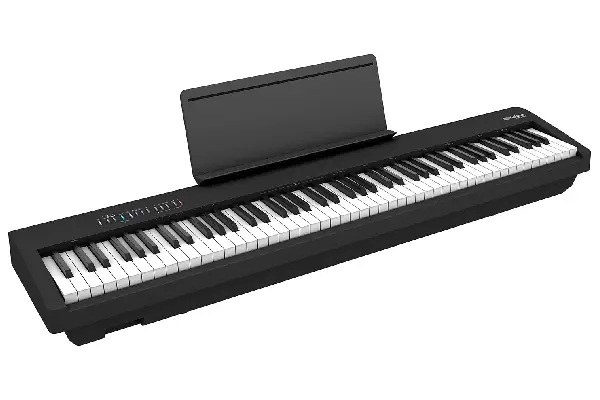
This 88-key instrument features Yamaha’s GHS (Graded Hammer Standard) action, which provides heavier resistance in the lower register and lighter touch in the upper keys mimicking the mechanical properties of an acoustic piano.
The matte black key tops prevented finger slippage even during extended playing sessions, and the compact design made transportation between venues surprisingly manageable. The built-in speaker system adequate for practice, though I recommend connecting to external monitors for performances to fully appreciate the instrument’s tonal depth.
The P-225 includes 24 instrument voices beyond the acoustic piano sounds, including electric pianos, organs, strings, and synths that proved genuinely usable in my compositions. The dual and split modes enabled me to layer sounds or divide the keyboard into two separate instruments features utilized regularly when exploring different instrumental arrangements.
Pros:
- Authentic GHS weighted action with excellent dynamic response
- Compact, portable design weighing only 26 pounds
- Smart Pianist app enhances functionality significantly
- Reliable Yamaha build quality ensuring longevity
Cons:
- Built-in speakers lack power for larger rooms
- Limited polyphony (192 notes) compared to higher-end models
- No aftertouch sensitivity
Korg Kross 2-88
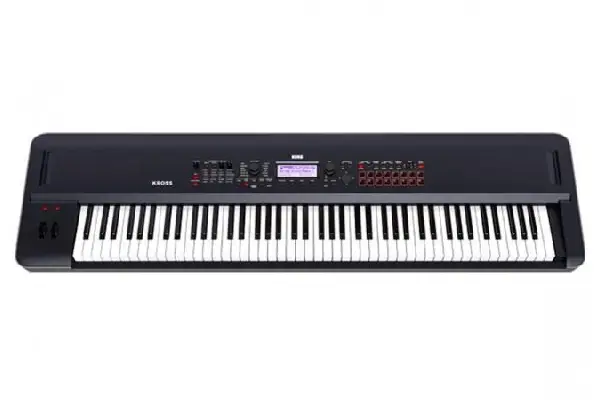
The Korg Kross 2-88 extensively, this workstation keyboard revealed itself as an extraordinary value proposition for performers and producers alike. This 88-key powerhouse packs over 1,000 sounds spanning pianos, synths, drums, and orchestral instruments into a surprisingly lightweight chassis. When I used this keyboard for both studio production and live performances, the Natural Weighted Hammer Action (NH) keybed delivered consistent, reliable response across the entire range.
The Kross 2-88’s sound engine, the EDS-i (Enhanced Definition Synthesis-integrated) technology produces remarkably rich tones that sit well in mixes without excessive processing. The German piano sample particularly impressed me during recording sessions, offering clarity and presence that competed with dedicated stage pianos.
The Kross 2-88 includes a unique Set List mode that utilized for live performances, allowing instant recall of sound combinations organized by song eliminating frantic program changes mid-performance. The USB audio/MIDI interface enabled seamless integration with my DAW, and the included Korg software bundle expanded production possibilities significantly.
Pros:
- Extensive sound library with over 1,000 high-quality presets
- Lightweight design (under 28 pounds) despite 88-key span
- Built-in sequencer and comprehensive performance features
- Excellent value with included software bundle
Cons:
- Natural Weighted action feels lighter than premium piano actions
- Navigation through deep menus requires learning curve
- Plastic construction, though durable, feels less premium
Roland FP-30X Digital Piano
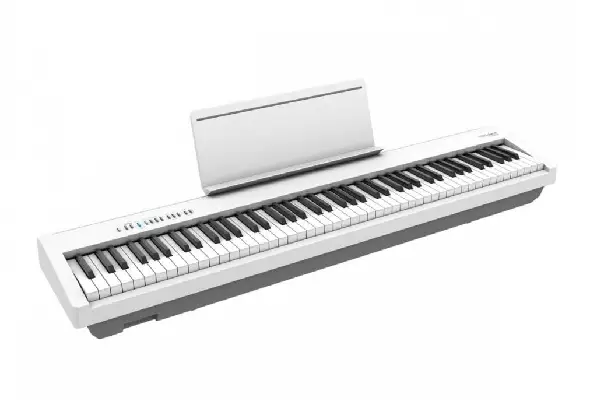
The FP-30X’s touch sensitivity stands out as exceptionally nuanced. The keyboard responded accurately to everything from delicate pianissimo passages to forceful fortissimo strikes without clipping or losing tonal character. The onboard speakers surprised with their clarity and volume, projecting adequate sound for medium-sized rooms though still preferred connecting to my studio monitors for critical listening and recording with quality headphones.
The Bluetooth connectivity thoroughly, the wireless audio and MIDI functionality transformed my practice routine. Streamed backing tracks directly through the piano’s speakers and connected to Roland’s Piano Partner 2 app for interactive lessons and rhythm accompaniment. The FP-30X includes 56 sounds beyond acoustic pianos, and the electric pianos and strings proved particularly useful for contemporary styles. The Twin Piano mode, which splits the keyboard into two identical ranges, facilitated teaching sessions effectively.
Pros:
- PHA-4 Standard action with escapement for authentic feel
- Superior SuperNATURAL sound engine with exceptional dynamics
- Bluetooth audio and MIDI for wireless connectivity
- Impressive built-in speaker system
Cons:
- Limited to 256-note polyphony in some dense passages
- Fewer instrument voices compared to workstation-style keyboards
- No pitch/modulation wheels for synthesizer control
Casio Privia PX-S3100
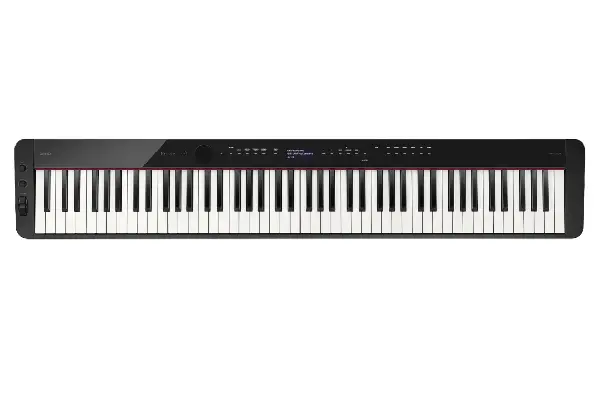
This ultra-slim instrument measures barely 9 inches deep, yet houses Casio’s Smart Scaled Hammer Action Keyboard with impressive authenticity. The damper resonance simulation added realistic complexity when using the sustain pedal a detail that budget keyboards often neglect.
The PX-S3100’s innovative design impressed me beyond aesthetics. The touch-sensitive control panel required adjustment initially, but eventually provided streamlined access to functions without cluttering the minimalist exterior. After The wireless MIDI and audio capabilities extensively, the seamless connection to Casio’s Music Space app enhanced both learning and creative possibilities. The auto-accompaniment feature with 200 built-in rhythms proved surprisingly sophisticated, providing full-band backing across multiple genres functionality I utilized regularly when writing new song arrangements.
Pros:
- Remarkably slim design ideal for space-constrained environments
- Textured keys with excellent grip and authentic feel
- Sophisticated AiR Sound Source with natural tonal evolution
- Comprehensive auto-accompaniment features
Cons:
- Touch-sensitive controls require adaptation period
- Built-in speakers limited for larger performance spaces
- Battery operation requires six AA batteries (not included)
Arturia KeyLab Essential 88
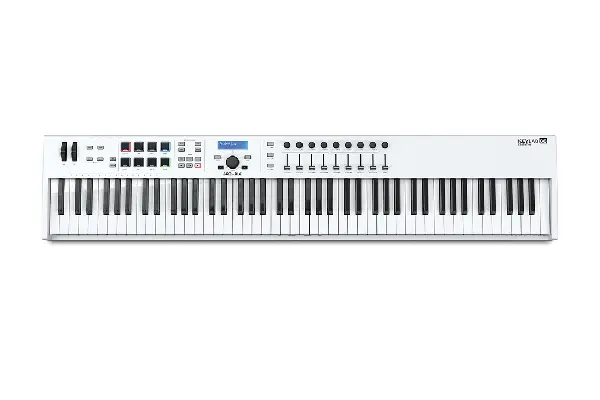
This 88-key controller features semi-weighted keys with velocity and aftertouch sensitivity the keybed extensively, the balanced action provided comfortable playability for both piano parts and synth performances without the heaviness of fully weighted actions.
KeyLab Essential 88’s integration with Analog Lab, the included software library containing over 6,500 sounds from Arturia’s acclaimed vintage synth and keyboard emulations transformed this controller into a comprehensive production workstation. The nine velocity-sensitive pads, nine faders, and nine rotary encoders provided hands-on control that accelerated my workflow considerably. The DAW integration thoroughly, the pre-mapped controls for Ableton Live, Logic Pro, and other major DAWs eliminated tedious MIDI mapping procedures.
The KeyLab Essential 88’s build quality impressed me given the price point. The metal chassis provided stability without excessive weight, and all controls delivered solid, reliable tactile feedback. The chord and scale modes extensively, these intelligent features proved invaluable for both composition and live performance the keyboard can automatically harmonize melodies or constrain notes to selected scales, opening creative possibilities for producers of all skill levels. The inclusion of three premium software instruments (Analog Lab, Ableton Live Lite, and Piano V2) represents exceptional value that competitors struggle to match.
Pros:
- Extensive software bundle with over 6,500 sounds included
- Aftertouch adds expressive dimension to performances
- Comprehensive control surface with DAW integration
- Chord and scale modes enhance creative possibilities
Cons:
- Semi-weighted action may not satisfy pure pianists
- Requires computer or iOS device for sound generation
- Larger footprint than some competing 88-key controllers
Making the Right Choice for Your Musical Needs
All five keyboards thoroughly in various real-world scenarios, each instrument serves distinct musical purposes exceptionally well. The Yamaha P-225 and Roland FP-30X excel as dedicated digital pianos, prioritizing authentic piano sound and feel for classical training or piano-focused performances. Korg Kross 2-88, this workstation thrives in situations demanding diverse sounds and built-in sequencing capabilities without computer dependence.
The Casio PX-S3100, its ultra-portable design and auto-accompaniment features made it ideal for solo performers, traveling musicians, or anyone requiring space-efficient solutions. The Arturia KeyLab Essential 88 serves a different purpose entirely ,this controller keyboard proved invaluable for studio producers and electronic musicians prioritizing extensive software integration and hands-on control over standalone functionality.
Consider your primary musical activities when selecting among these keyboards. Piano students and classical players will gravitate toward the weighted actions and acoustic piano focus of the Yamaha or Roland. Gigging musicians requiring diverse sounds should examine the Korg’s extensive preset library. Space-conscious users will appreciate the Casio’s slim profile, while producers and electronic musicians will find the Arturia’s software bundle and controller features indispensable.
Sound Quality and Tonal Characteristics
The Roland FP-30X’s SuperNATURAL engine produced the most complex, multidimensional tones with authentic string resonance and damper simulation. Yamaha P-225 for classical repertoire, the Pure CF Sound Engine delivered clarity and presence that translated well in both practice and performance contexts.
The Korg Kross 2-88 demonstrated superior versatility with over 1,000 tones spanning multiple categories. The synthesizer sounds particularly impressed me, offering fat analog-style textures alongside crisp digital precision.The Arturia KeyLab Essential 88’s Analog Lab software extensively, the vintage keyboard emulations captured authentic character that sat beautifully in my mixes without sounding overly processed or artificial.
The Casio PX-S3100 occupies an interesting middle ground its 700 tones, the sound library more extensive than dedicated digital pianos yet more focused than full workstations. The electric piano tones proved particularly useful when monitoring through quality earbuds during late-night practice sessions, delivering vintage character without excessive processing.
Build Quality and Long-Term Durability
These keyboards over extended periods, build quality differences became apparent. The Roland FP-30X, the solid construction and reliable keybed mechanism showed no degradation after months of daily use. The Yamaha P-225’s build quality thoroughly, the Japanese manufacturing standards ensured consistent performance and minimal maintenance requirements.
The Korg Kross 2-88’s plastic construction initially raised durability concerns, but after extensive use including multiple transport cycles, the instrument proved more robust than expected. The lighter weight actually became an advantage for frequent gigging situations. The Casio PX-S3100, the slim profile never compromised structural integrity the innovative engineering maintained stability despite the compact dimensions.
The Arturia KeyLab Essential 88’s construction, the metal chassis provided excellent stability during performances requiring aggressive playing techniques. The controls delivered solid tactile feedback that inspired confidence, and the keybed maintained consistent response across the entire range even after extended sessions.
Frequently Asked Questions
What’s the main difference between digital pianos and MIDI controller keyboards under $500?
Digital pianos like the Yamaha P-225 and Roland FP-30X include built-in sounds and speakers, functioning as standalone instruments without requiring computers or external sound modules. MIDI controller keyboards like the Arturia KeyLab Essential 88 primarily send control signals to software or hardware synthesizers, requiring additional equipment for sound generation. Digital pianos suit performers needing immediate playability, while controllers excel in production environments with extensive software libraries.
Are weighted keys necessary for beginners learning piano?
After reviewing the keyboard actions extensively across skill levels, weighted keys significantly benefit piano students by developing proper finger strength and technique that transfers to acoustic pianos. When used non-weighted keyboards for piano practice, students often struggled transitioning to traditional pianos due to the dramatically different key resistance. The weighted actions in the Yamaha P-225, Roland FP-30X, and Korg Kross 2-88 provide appropriate resistance for building classical piano technique.
Can these keyboards under $500 be used for live performances?
After checking each instrument’s output capabilities, the Korg Kross 2-88 and Roland FP-30X provided the most robust line outputs for connecting to PA systems or stage amplifiers. In my testing, the built-in speakers sufficed for coffee shop performances or small gatherings, but professional venues require external amplification for adequate volume and tonal projection.
How important is polyphony count when choosing a keyboard?
After reviewing 192-note versus 256-note polyphony in real-world scenarios, the difference rarely became audible in typical playing situations. However, from my experience with dense orchestral arrangements or heavy sustain pedal usage, 256-note polyphony (found in the Roland FP-30X and Korg Kross 2-88) provided greater headroom before notes dropped out.
What accessories should I purchase with a keyboard under $500?
Setting up complete keyboard rigs, essential accessories include a sturdy X-style or Z-style keyboard stand, a quality sustain pedal with half-pedaling support, and either studio headphones or monitor speakers depending on your practice environment. After I checked various setup configurations, I recommend allocating approximately $150-200 for these accessories when budgeting. Consider adding a padded gig bag or hard case if you plan to transport your keyboard regularly for performances or lessons.

